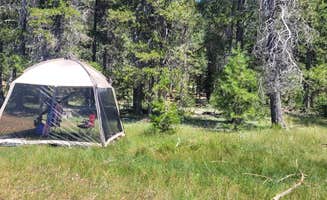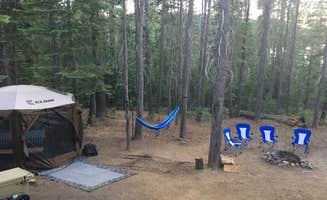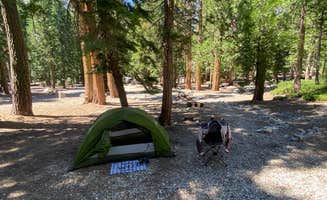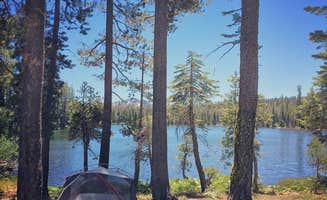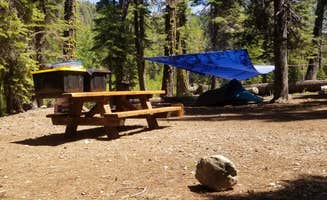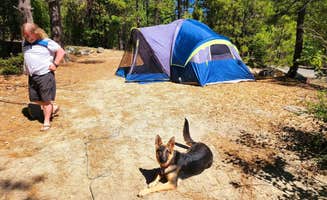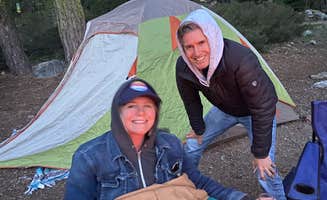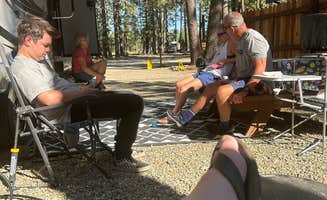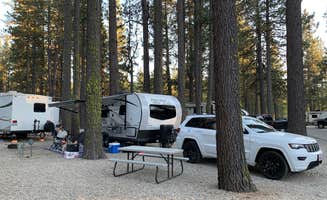Dispersed camping opportunities abound throughout Plumas National Forest, situated at elevations ranging from 2,000 to 7,000 feet in the northern Sierra Nevada. The forest's diverse terrain includes dense pine forests, alpine meadows, and numerous lakes and streams that create natural boundaries between camping areas. Summer temperatures typically range from 50°F at night to 80°F during the day at mid-elevations, with cooler conditions at higher altitudes.
What to do
Hiking to alpine lakes: From Sardine Lake, campers can access trails to multiple lakes. "Our site was great, but didn't have very much shade. It was nice to be hike up to volcano lake from our campsite as well as sardine lake and upper sardine lake," notes Erika B. The hike to Upper Sardine Lake takes about an hour round trip.
Gold panning in mountain streams: Union Flat Campground offers access to streams for gold panning. "Been there many times in the 90s, good gold panning results," reports Bull D. The North Yuba River runs adjacent to several campsites, providing easy access to traditional panning spots.
Mountain biking on forest trails: The Downieville area offers extensive trail systems for cyclists. "Great mtn biking, fishing, rafting, floating and swimming. Fly fishing is on fire, if you have a spin rod throw a bubble and 7 foot leader and watch the little guys come on in," shares Keef W. about Union Flat Campground. Most trails are accessible from May through October, depending on snowmelt.
What campers like
Swimming holes and water access: Campers frequently mention the quality of swimming spots. "We stayed at 7A which had zero shade, but did have access to the swimming hole. Our kids loved this campground. The swimming hole was awesome," writes Kristin P. about Union Flat Campground. The swimming areas are typically most comfortable in July and August.
Mountain views from campsites: Running Deer Campground offers lakeside sites with mountain vistas. "Great spaces next to lake. No cell service. Lots of places to enjoy on the shoreline," mentions Michael B. The sites provide direct access to Little Grass Valley Reservoir.
Disconnecting from technology: Many campers appreciate the lack of connectivity. "No cell service and no services at the campsite so pick up firewood from the one motel/cafe/gas/market on the way in," advises Danielle B. about Sardine Lake. Most remote campgrounds in the forest have no cell reception, allowing for a true digital detox.
What you should know
Road conditions vary significantly: Many forest roads require high-clearance vehicles. "The drive into the campground is nerve wracking. We are from northern california so we are usually fine but bumpy roads. But towing a trailer I was surprised to find the drive in was partially on a gravel road," cautions Stacie L. about Red Feather Campground.
Seasonal facilities: Most campgrounds operate on limited seasons. "We went here last August. It was quite, the water was warm, the people where great," reports Linda L. about Red Feather Campground, which typically operates from mid-June through late August.
Weekday vs. weekend atmosphere: The camping experience changes dramatically between weekdays and weekends. "We stayed here for three nights. Two of those nights were during the week. Friday night had a completely different vibe- lots of parties and loud music," explains Kristin P. about Union Flat Campground. Planning a mid-week stay can provide a quieter experience.
Tips for camping with families
Seek out swimming options: Plumas-Eureka State Park Campground offers family-friendly water features. "A creek goes through the middle and is great in the summer for a nice cool down," shares Amanda H. Many families gravitate toward sites near water during summer months.
Bring appropriate bear protection: Wildlife encounters require preparation. "We were sure to use the bear box properly as a bear had been spotted in the campground that morning," notes Kiley S. about Plumas-Eureka State Park Campground. Most established campgrounds provide bear boxes, but dispersed campers must bring proper food storage containers.
Look for family-specific amenities: Some campgrounds cater specifically to families. "Kid friendly with activities and play areas. Pet park for off leash play! Clean and friendly staff," reports Ben W. about Clio's Rivers Edge RV Park. Families often prefer campgrounds with designated play areas or short hiking trails suitable for young children.
Tips from RVers
Site access considerations: Clio's Rivers Edge RV Park offers guided parking assistance. "They escort you to your site and guide you (definitely a marriage saver!) to ensure you get parked safely in your perfectly hand raked graveled spot," shares Monique D. This service is particularly valuable for those new to RV camping.
Space limitations: Some RV parks have tight spacing between sites. "Every space is so close to each other, you have next to you their services and it's impossible to access your storage without bothering your neighbors," cautions Mar S. about Clio's Rivers Edge RV Park. RVers with larger rigs should call ahead to confirm site dimensions.
Consider dump station availability: Many forest campgrounds lack full hookups. "Great location and overall a great RV park. The staff was super friendly and helpful. The park is immaculately maintained. The sites are level and the scenery is breathtaking," notes Melanie R. Several RV parks around the forest perimeter offer full hookup services, while forest campgrounds typically provide vault toilets only.


